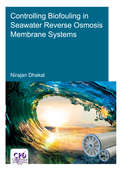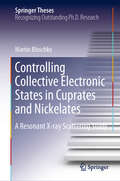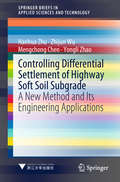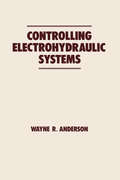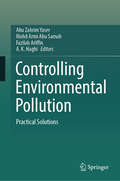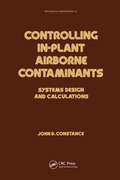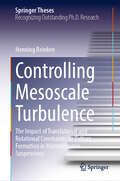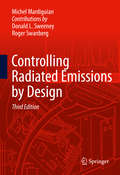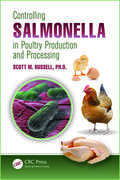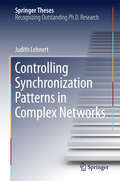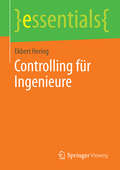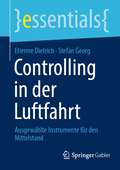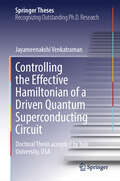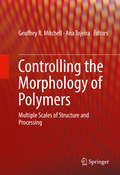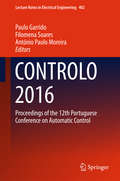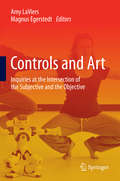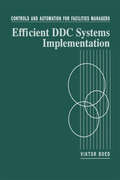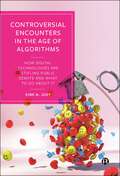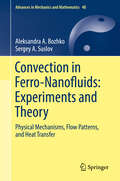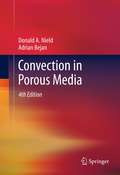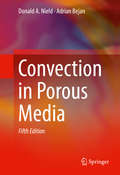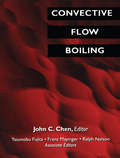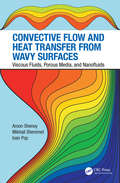- Table View
- List View
Controlling Biofouling in Seawater Reverse Osmosis Membrane Systems (IHE Delft PhD Thesis Series)
by Nirajan DhakalSeawater desalination is a rapidly growing coastal industry that is increasingly threatened by algal blooms. Depending on the severity of algal blooms, desalination systems may be forced to shut down because of clogging and/or poor feed water quality. To maintain stable operation and provide good feed water quality to seawater reverse osmosis (SWRO) systems, ultrafiltration (UF) pre-treatment is proposed.This research focused on assessing the ability of UF and other pre-treatment technologies to reduce biofouling in SWRO systems. An improved method to measure bacterial regrowth potential (BRP) was developed and applied at laboratory, pilot and full scale to assess the ability of conventional UF (150 kDa) and tight UF (10 kDa) alone and in combination with a phosphate adsorbent to reduce regrowth potential and delay the onset of biofouling in SWRO.The improved bacterial regrowth potential method employs a natural consortium of marine bacteria as inoculum and flow cytometry. The limit of detection of the BRP method was lowered to 43,000 ± 12,000 cells/mL, which is equivalent to 9.3 ± 2.6 µg-Cglucose/L.The reduction in bacterial regrowth potential after tight UF (10 kDa) was 3 to 4 times higher than with conventional UF (150 kDa). It was further reduced after the application of a phosphate adsorbent, independent of pore size of the UF membrane. Pilot studies demonstrated that the application of tight UF (10 kDa) coupled with a phosphate adsorbent consistently lowered the bacterial regrowth potential and no feed channel pressure drop increase was observed in membrane fouling simulators (MFS) over a period of 21 days. The study also showed that non-backwashable fouling of UF membranes varied strongly with the type of algal species and the algal organic matter (AOM) they release. The presence of polysaccharide (stretching -OH) and sugar ester groups (stretching S=O) was the main cause of non-backwashable fouling.In conclusion, this study showed that an improved BRP method is suitable for the assessment of SWRO pre-treatment systems and it can be a useful tool to develop potential strategies to mitigate biofouling and improve the sustainability of SWRO systems.
Controlling Collective Electronic States in Cuprates and Nickelates: A Resonant X-ray Scattering Study (Springer Theses)
by Martin BluschkeIn this thesis chemical and epitaxial degrees of freedom are used to manipulate charge and spin ordering phenomena in two families of transition metal oxides, while taking advantage of state-of-the-art resonant x-ray scattering (RXS) methods to characterize their microscopic origin in a comprehensive manner. First, the relationship of charge density wave order to both magnetism and the "pseudogap" phenomenon is systematically examined as a function of charge-carrier doping and isovalent chemical substitution in single crystals of a copper oxide high-temperature superconductor. Then, in copper oxide thin films, an unusual three-dimensionally long-range-ordered charge density wave state is discovered, which persists to much higher temperatures than charge-ordered states in other high-temperature superconductors. By combining crystallographic and spectroscopic measurements, the origin of this phenomenon is traced to the epitaxial relationship with the underlying substrate. This discovery opens new perspectives for the investigation of charge order and its influence on the electronic properties of the cuprates. In a separate set of RXS experiments on superlattices with alternating nickel and dysprosium oxides, several temperature- and magnetic-field-induced magnetic phase transitions are discovered. These observations are explained in a model based on transfer of magnetic order and magneto-crystalline anisotropy between the Ni and Dy subsystems, thus establishing a novel model system for the interplay between transition-metal and rare-earth magnetism.
Controlling Differential Settlement of Highway Soft Soil Subgrade: A New Method And Its Engineering Applications (SpringerBriefs in Applied Sciences and Technology)
by Hanhua Zhu Mengchong Chen Zhijun Wu Yongli ZhaoDrawing on years of practical on-site experience, this book presents a new method for controlling "bridge-head bumping" in soft soil ground. Based on deformation compatibility and control theory of structure, it proposes strategies for improving the design method of soft soil ground and the effective "bridge-head bumping" control method. Soft soil ground is chiefly characterized by a large void ratio, high compressibility, high water content, low impermeability, low strength, strong structure and high sensitivity. As a result, it has pronounced rheological properties, and controlling "bridge-head bumping" in soft soil ground is essential to control the amount of soil rheology-induced unstable successive settlement. The book offers extensive information on this and related topics, making it a valuable guide for engineers in Civil Engineering and Geotechnical Engineering alike.
Controlling Electrohydraulic Systems (Fluid Power And Control Ser. #7)
by Wayne AndersonThis book discusses the pump's role in electrohydraulic systems and its use as a power source to a control loop, and provides a good understanding of the basics, complemented by working knowledge of the "real world." It is intended for engineers and students who have studied feedback control theory.
Controlling Environmental Pollution: Practical Solutions
by Abu Zahrim Yaser A. K. Haghi Mohd Armi Abu Samah Fazilah AriffinThis book highlights current efforts and research on pollution management and advanced technology for pollution treatment. It presents an overview of various aspects of environmental pollution, including water resources management in minimizing the pollution effect. Recent achievements in air pollution monitoring and control including sustainable urban design are also discussed. Chapters in the book also focus on tackling food waste disposal and advanced techniques on pollution treatment. The book concludes with a discussion of a special case study on Malaysian agricultural industry efforts to tackle pollution.
Controlling In-Plant Airborne Contaminants: Systems Design and Calculations
by John D. ConstanceThis book is a useful reference work for practicing engineers in their evaluation and design of systems for the control of the industrial in-plant environment. It provides design criteria, useful calculations and proven techniques to control the environment in oil refineries and chemical industries.
Controlling Language in Industry: Controlled Languages for Technical Documents
by Stephen CrabbeThis book provides an in-depth study of controlled languages used in technical documents from both a theoretical and practical perspective. It first explores the history of controlled languages employed by the manufacturing industry to shape and constrain the information in technical documents. The author then offers a comparative analysis of existing controlled languages and distills the best-practice features of those language systems. He concludes by offering innovative models that can be used to develop and trial a new controlled language. This book will be of interest to linguists working in technical and professional communication, as well as writers and practitioners involved in the production of technical documents for companies in multiple industries and geographical locations.
Controlling Light in Optically Induced Photonic Lattices (Springer Theses)
by Bernd TerhalleDiscrete periodic structures play an important role in physics, and have opened up an exciting new area of investigation in recent years. Questions relating to the control of light in such structures still represent a major challenge. It is this highly active field that is addressed in the present thesis. Using the model system of a photorefractive nonlinearity that allows one to simultaneously create and control photonic lattices by light, the author obtains a comprehensive picture of the control of nonlinear and quantum optics phenomena in photonic lattices. He describes and demonstrates experimentally for the first time resonant transitions in two-dimensional hexagonal lattices, including Rabi oscillations and Landau-Zener tunneling, as well as the direct control and exploitation of these transitions. A particular highlight of this thesis is the study of soliton-cluster switching and control of Zener tunneling.
Controlling Mesoscale Turbulence: The Impact of Translational and Rotational Constraints on Pattern Formation in Microswimmer Suspensions (Springer Theses)
by Henning ReinkenThis thesis combines methods from statistical physics and nonlinear dynamics to advance research on the pattern formation in active fluids in several directions. In particular, it focuses on mesoscale turbulence, a state observed in microswimmer suspensions, which is characterized by the emergence of dynamic vortex patterns. The first major contribution concerns the bottom-up derivation of a frequently used continuum model of mesoscale turbulence from a set of particle-resolved stochastic equations. Utilizing the model, mesoscale turbulence is shown to induce nontrivial transport properties including a regime of optimal diffusion. The thesis then explores possible strategies of control. One of these relies on an external field that leads to stripe-like structures and can even suppress patterns entirely. The other involves geometric confinement realized by strategically placed obstacles that can reorganize the flow into a variety of ordered vortex structures. The turbulence transition inside an obstacle lattice is shown to have an intriguing analogy to an equilibrium transition in the Ising universality class. As a whole, this thesis provides important contributions to the understanding and control of turbulence in active fluids, as well as outlining exciting future directions, including applications. It includes a substantial introduction to the topic, which is suitable for newcomers to the field.
Controlling Radiated Emissions by Design (The\springer International Series In Engineering And Computer Science Ser. #580)
by Michel MardiguianThe 3rd edition of Controlling Radiated Emissions by Design has been updated to reflect the latest changes in the field. New to this edition is material on aspects of technical advance, specifically long term energy efficiency, energy saving, RF pollution control, etc. This book retains the step-by-step approach for incorporating EMC into every new design, from the ground up. It describes the selection of quieter IC technologies, their implementation into a noise-free printed circuit layout, and the gathering of all these into low radiation packaging, including I/O filtering, connectors and cables considerations. All guidelines are supported by thorough and comprehensive calculated examples. Design engineers, EMC specialists and technicians will benefit from learning about the development of more efficient and economical control of emissions.
Controlling Salmonella in Poultry Production and Processing
by Ph.D., Scott RussellSalmonella is a major pathogen that can result in deadly foodborne illness. The Centers for Disease Control and Prevention (CDC) estimates that there are 1.4 million cases of Salmonella poisoning each year in the United States from a variety of causes, with undercooked poultry and eggs being the prime culprits. Therefore, intervention strategies ar
Controlling Synchronization Patterns in Complex Networks (Springer Theses)
by Judith LehnertThis research aims to achieve a fundamental understanding of synchronization and its interplay with the topology of complex networks. Synchronization is a ubiquitous phenomenon observed in different contexts in physics, chemistry, biology, medicine and engineering. Most prominently, synchronization takes place in the brain, where it is associated with several cognitive capacities but is - in abundance - a characteristic of neurological diseases. Besides zero-lag synchrony, group and cluster states are considered, enabling a description and study of complex synchronization patterns within the presented theory. Adaptive control methods are developed, which allow the control of synchronization in scenarios where parameters drift or are unknown. These methods are, therefore, of particular interest for experimental setups or technological applications. The theoretical framework is demonstrated on generic models, coupled chemical oscillators and several detailed examples of neural networks.
Controlling für Ingenieure (essentials)
by Ekbert HeringControlling stellt ein ziel-, nutzen- und engpassorientiertes Führungskonzept dar, mit dem Unternehmen kurz-, mittel- und langfristig erfolgreich geführt werden können. Die Ziele werden in Planungen festgehalten, die messbare Soll-Werte enthalten. Werden die tatsächlichen Ist-Werte gemessen, so kann man die Abweichungen von den Planwerten feststellen. Diese Abweichungen lösen eine Steuerung durch Anpassungsmaßnahmen zur Zielerreichung oder Korrektur der Zielgrößen aus. Es wird zwischen strategischem und operativem Controlling unterschieden. Das strategische Controlling dient zur Existenzsicherung, indem es die langfristigen Ziele anhand der Erkenntnisse über zukünftige Marktchancen und -risiken unter Berücksichtigung der eigenen Möglichkeiten und Stärken festlegt. Aufgabe des operativen Controllings ist die Sicherung der Lebensfähigkeit des Unternehmens (Liquidität), einer angemessenen Verzinsung des eingesetzten Kapitals (Rentabilität) sowie ein optimales Kosten- und Leistungsverhältnis (Wirtschaftlichkeit). Strategisches und operatives Controlling werden für alle Funktionen des Unternehmens erläutert.
Controlling in der Luftfahrt: Ausgewählte Instrumente für den Mittelstand (essentials)
by Stefan Georg Etienne DietrichLuftfahrtunternehmen befinden sich in einem Markt mit hohen Wachstumsraten, doch immer wieder erschüttern Krisen die Luftfahrt. Doch nicht nur krisenbedingte Nachfrageeinbrüche stellen Luftfahrtunternehmen vor Schwierigkeiten, auch die fortwährende Globalisierung und der zunehmende Marktwettbewerb - vor allem durch Low Cost Airlines - führen selbst in Wachstumszeiten immer wieder zu Insolvenzen von Luftfahrtunternehmen. Letztlich müssen sie im hart umkämpften Markt Strategien finden, um dauerhaft bestehen zu können. Als Lösungsansatz bildet das Controlling gerade auch für mittelständische Luftfahrtunternehmen eine notwendige Methodik, um die Effizienz der Unternehmung zu sichern.Dieses Buch zeigt Ihnen typische Controllinginstrumente, die sich gerade für den Mittelstand eignen. Neben der Deckungsbeitragsrechnung sind die Anwendung des Revenue Managements und der Einsatz von Kennzahlen diskutiert.
Controlling the Effective Hamiltonian of a Driven Quantum Superconducting Circuit (Springer Theses)
by Jayameenakshi VenkatramanThe thesis illustrates, with a remarkable combination of theoretical analysis and experimental investigation, how the static Hamiltonian of an oscillator with both 3rd and 4th order non-linearity can morph into a profoundly different Hamiltonian under the influence of an oscillating driving force. In a classical system, such transformation would not be considered a novelty, but the author demonstrates that the new Hamiltonian can possess an exotic symmetry with surprising new quantum properties that one would never anticipate from the original Hamiltonian, with no classical equivalent. The root cause of these unexpected properties is a subtle interference effect, which is only possible in a quantum context. Carefully crafted control experiments ensure that measured data are compared with theoretical predictions with no adjustable parameters. Instrumental in this comparison is a new diagrammatic theory developed by the author.
Controlling the Morphology of Polymers: Multiple Scales of Structure and Processing
by Geoffrey R. Mitchell Ana TojeiraThis book focuses on controlling morphology of different scales for polymers. The authors explain the need for successful control of morphology to yield target macroscopic physical properties in the application of polymers to diverse areas such as engineering materials, nanodielectrics and photonic crystals. The book combines specialized chapters with an introduction to the morphology of polymers and the range of experimental techniques available to evaluate it.
Controlo 2016: Proceedings of the 12th Portuguese Conference on Automatic Control (Lecture Notes in Electrical Engineering #402)
by Paulo Garrido Filomena Soares António Paulo MoreiraThe biennial CONTROLO conferences are the main events promoted by The CONTROLO 2016 12th Portuguese Conference on Automatic Control, Guimaraes, Portugal, September 14th to 16th, was organized by Algoritmi, School of Engineering, University of Minho, in partnership with INESC TEC, and promoted by the Portuguese Association for Automatic Control APCA, national member organization of the International Federation of Automatic Control IFAC. The seventy-five papers published in this volume cover a wide range of topics. Thirty-one of them, of a more theoretical nature, are distributed among the first five parts: Control Theory; Optimal and Predictive Control; Fuzzy, Neural and Genetic Control; Modeling and Identification; Sensing and Estimation. The papers go from cutting-edge theoretical research to innovative control applications and show expressively how Automatic Control can be used to increase the well being of people. "
Controls and Art: Inquiries at the Intersection of the Subjective and the Objective
by Magnus Egerstedt Amy LaviersDancing humanoids, robotic art installations, and music generated by mathematically precise methods are no longer science fiction; in fact they are the subject of this book. This first-of-its-kind anthology assembles technical research that makes such creations possible. In order to mechanize something as enigmatic and personal as dance, researchers must delve deeply into two distinct academic disciplines: control theory and art. Broadly, this research uses techniques from the world of art to inspire methods in control, enables artistic endeavours using advanced control theory and aids in the analysis of art using metrics devised by a systems theoretic approach. To ensure that artistic influences are well represented, the individual chapters are focused so that they relate their contribution to the arts meaningfully and explicitly. Specially composed introductions set up the contributions either in terms of inspiration by artistic principles or their contribution to the arts through new analysis tools. To facilitate this, the majority of the chapters are authored jointly by experts in control theory and by artists, including dancers, choreographers, puppeteers and painters. Connections between controls and art then permeate the text so that these important relationships play a central role in the book. Controls and Art surveys current projects in this area--including a disco dancing robot, a reactive museum exhibit and otherworldly music--and illuminates open problems and topics for research in this emerging interdisciplinary field. It will draw attention both from experts in robotics and control interested in developing the artistic side of their creations and from academics studying dance, theater, music and the visual arts with an interest in avant-garde means of production.
Controls and Automation for Facilities Managers: Efficient DDC Systems Implementation
by Viktor BoedThe first-ever complete guide to project management for facilities managers covers: how to write specifications, evaluate bids, and solve problems; all control and automation systems for new and retrofit buildings; cost-effective, energy-efficient solutions for all HVAC systems; and has complete coverage of single-building systems as well as multibuilding complexes.
Controversial Encounters in the Age of Algorithms: How Digital Technologies are Stifling Public Debate and What to Do About It
by Sine N. JustHow can we have meaningful public conversations in the algorithmic age? This book explores how digital technologies shape our opinions and interactions, often in ways that limit our exposure to diverse perspectives and fuel polarization. Drawing on the ancient art of arguing all sides of a case, the book offers a way to revive public debate as a source of trust and legitimacy in democratic societies. This is a timely and urgent book for anyone who cares about the future of democracy in the digital era.
Convection in Ferro-Nanofluids: Physical Mechanisms, Flow Patterns, and Heat Transfer (Advances in Mechanics and Mathematics #40)
by Aleksandra A. Bozhko Sergey A. SuslovThis book covers the experimental and theoretical study of convection in non-isothermal ferro-nanofluids (FNFs). Since FNFs are not transparent and magnetic fields are very sensitive to the shape of the boundary between magnetic and nonmagnetic media, special flow visualization techniques based on the use of thermo-sensitive liquid crystal films, infrared cameras, as well as local and integral temperature sensors are discussed in the book. This book considers several major configurations of convective chambers and the applied magnetic field. For each of them, the stability boundaries are determined theoretically and experimentally. The physical types of dominant instabilities and the characteristics of their interactions are subsequently established using linear and weakly non-linear hydrodynamic stability analyses and elements of bifurcation theory. The book also discusses the potential of using magnetically controlled ferro-nanofluids as a heat carrier in situations where heat removal by natural convection is not possible due to the lack of gravity (orbital stations) or extreme confinement (microelectronics). Researchers and practitioners working in the areas of fluid mechanics, hydrodynamic stability, and heat and mass transfer will benefit from this book.
Convection in Porous Media
by Adrian Bejan Donald A. NieldConvection in Porous Media, 4th Edition, provides a user-friendly introduction to the subject, covering a wide range of topics, such as fibrous insulation, geological strata, and catalytic reactors. The presentation is self-contained, requiring only routine mathematics and the basic elements of fluid mechanics and heat transfer. The book will be of use not only to researchers and practicing engineers as a review and reference, but also to graduate students and others entering the field. The new edition features approximately 1,750 new references and covers current research in nanofluids, cellular porous materials, strong heterogeneity, pulsating flow, and more.
Convection in Porous Media
by Adrian Bejan Donald A. NieldThis updated edition of a widely admired text provides a user-friendly introduction to the field that requires only routine mathematics. The book starts with the elements of fluid mechanics and heat transfer, and covers a wide range of applications from fibrous insulation and catalytic reactors to geological strata, nuclear waste disposal, geothermal reservoirs, and the storage of heat-generating materials. As the standard reference in the field, this book will be essential to researchers and practicing engineers, while remaining an accessible introduction for graduate students and others entering the field. The new edition features 2700 new references covering a number of rapidly expanding fields, including the heat transfer properties of nanofluids and applications involving local thermal non-equilibrium and microfluidic effects.
Convective Flow Boiling
by John C. ChenThis book comprises selected papers from the First International Conference on Convective Flow Boiling. The purpose of the conference is to examine state-of-science and recent developments in technology of flow boiling, i.e., boiling systems which are affected by convective flows.
Convective Flow and Heat Transfer from Wavy Surfaces: Viscous Fluids, Porous Media, and Nanofluids
by Aroon Shenoy Mikhail Sheremet Ioan PopConvective Flow and Heat Transfer from Wavy Surfaces: Viscous Fluids, Porous Media, and Nanofluids addresses the wavy irregular surfaces in heat transfer devices. Fluid flow and heat transfer studies from wavy surfaces have received attention, since they add complexity and require special mathematical techniques. This book considers the flow and heat transfer characteristics from wavy surfaces, providing an understanding of convective behavioral changes.
